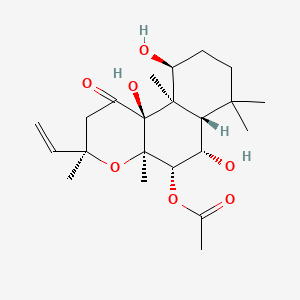| MeSH term | MeSH ID | Detail |
|---|---|---|
| Hemolysis | D006461 | 131 associated lipids |
| Diarrhea | D003967 | 32 associated lipids |
| Diabetes Mellitus | D003920 | 90 associated lipids |
| Hearing Loss, Sensorineural | D006319 | 8 associated lipids |
| Graft Occlusion, Vascular | D006083 | 11 associated lipids |
| Arrhythmias, Cardiac | D001145 | 42 associated lipids |
| Hypercalcemia | D006934 | 13 associated lipids |
| Neovascularization, Pathologic | D009389 | 39 associated lipids |
| Tumor Virus Infections | D014412 | 8 associated lipids |
| Adenocarcinoma | D000230 | 166 associated lipids |
forskolin
Forskolin is a lipid of Prenol Lipids (PR) class. Forskolin is associated with abnormalities such as Cholestasis, Vocal cord dysfunction familial, Hypothyroidism, Renal tubular disorder and Disintegration (morphologic abnormality). The involved functions are known as Cell Proliferation, Anabolism, mRNA Expression, Agent and Signal. Forskolin often locates in Extracellular, Body tissue, Skin, Tissue membrane and Membrane. The associated genes with forskolin are P4HTM gene, SLC33A1 gene, NR1I2 gene, Genes, Reporter and CYP3A gene. The related lipids are Steroids, steroid sulfate, Fatty Acids, LYSO-PC and Lipopolysaccharides.
Cross Reference
Introduction
To understand associated biological information of forskolin, we collected biological information of abnormalities, associated pathways, cellular/molecular locations, biological functions, related genes/proteins, lipids and common seen animal/experimental models with organized paragraphs from literatures.
What diseases are associated with forskolin?
forskolin is suspected in Cyst, Kozlowski Celermajer Tink syndrome, Vocal cord dysfunction familial, Alzheimer's Disease, Cholestasis, Renal tubular disorder and other diseases in descending order of the highest number of associated sentences.
Related references are mostly published in these journals:
- J. Biol. Chem. (4)
- Am. J. Physiol. Endocrinol. Metab. (1)
- Am. J. Physiol. Regul. Integr. Comp. Physiol. (1)
- Others (9)
| Disease | Cross reference | Weighted score | Related literature |
|---|
Possible diseases from mapped MeSH terms on references
We collected disease MeSH terms mapped to the references associated with forskolin
PubChem Associated disorders and diseases
What pathways are associated with forskolin
Lipid pathways are not clear in current pathway databases. We organized associated pathways with forskolin through full-text articles, including metabolic pathways or pathways of biological mechanisms.
Related references are published most in these journals:
| Pathway name | Related literatures |
|---|
PubChem Biomolecular Interactions and Pathways
Link to PubChem Biomolecular Interactions and PathwaysWhat cellular locations are associated with forskolin?
Visualization in cellular structure
Associated locations are in red color. Not associated locations are in black.
Related references are published most in these journals:
| Location | Cross reference | Weighted score | Related literatures |
|---|
What functions are associated with forskolin?
Related references are published most in these journals:
| Function | Cross reference | Weighted score | Related literatures |
|---|
What lipids are associated with forskolin?
Related references are published most in these journals:
| Lipid concept | Cross reference | Weighted score | Related literatures |
|---|
What genes are associated with forskolin?
Related references are published most in these journals:
| Gene | Cross reference | Weighted score | Related literatures |
|---|
What common seen animal models are associated with forskolin?
There are no associated biomedical information in the current reference collection.
NCBI Entrez Crosslinks
All references with forskolin
Download all related citations| Authors | Title | Published | Journal | PubMed Link |
|---|---|---|---|---|
| Wang B et al. | Differential involvement of signaling pathways in the regulation of growth hormone release by somatostatin and growth hormone-releasing hormone in orange-spotted grouper (Epinephelus coioides). | 2014 | Mol. Cell. Endocrinol. | pmid:24183819 |
| Kim S et al. | Alpha-synuclein interferes with cAMP/PKA-dependent upregulation of dopamine β-hydroxylase and is associated with abnormal adaptive responses to immobilization stress. | 2014 | Exp. Neurol. | pmid:24252179 |
| Stangherlin A et al. | Analysis of compartmentalized cAMP: a method to compare signals from differently targeted FRET reporters. | 2014 | Methods Mol. Biol. | pmid:24052380 |
| Onuma H et al. | The glucagon-like peptide 1 receptor agonist enhances intrinsic peroxisome proliferator-activated receptor γ activity in endothelial cells. | 2014 | Biochem. Biophys. Res. Commun. | pmid:25109805 |
| Hasan A et al. | Soluble adenylyl cyclase accounts for high basal cCMP and cUMP concentrations in HEK293 and B103 cells. | 2014 | Biochem. Biophys. Res. Commun. | pmid:24792377 |
| Pathomthongtaweechai N et al. | Pranlukast inhibits renal epithelial cyst progression via activation of AMP-activated protein kinase. | 2014 | Eur. J. Pharmacol. | pmid:24360935 |
| Kageyama K et al. | Stimulation of corticotropin-releasing factor gene expression by FosB in rat hypothalamic 4B cells. | 2014 | Peptides | pmid:24246425 |
| Shi X et al. | Cholesterol sulfate and cholesterol sulfotransferase inhibit gluconeogenesis by targeting hepatocyte nuclear factor 4α. | 2014 | Mol. Cell. Biol. | pmid:24277929 |
| Herrick JR | Reversible meiotic arrest in feline oocytes. | 2014 | Reprod. Fertil. Dev. | pmid:23327827 |
| Sharma KP et al. | Mechanisms of cAMP-induced sustained activation of extracellular signal-regulated kinase in the hippocampus. | 2014 | Neuroreport | pmid:24384504 |
